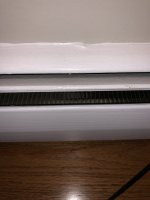Lochinvars tend to be on the pricey side. The WHB055 would easily handle the loads at your house, but would still probably be more expensive than the HTP UFT-080W by quite a bit.
The minimum fire input of the WHB085 is 8500 BTU/hr, the min-fire input of the WHB055 isn't a whole lot lower a 8300 BTU/hr, so the amount of radiation needed to keep it from short-cycling is about the same. The min-fire input of the UFT 080W is a bit lower at 8000 BTU/hr, but still in the same range.
What type of radiation do you have? If it's fin-tube baseboard just measure the lengths of the baseboard in each room on a zone to the nearest foot and add them all up. If it's cast iron radiators & cast iron baseboard estimate the total "
Equivalent Direct Radiation" square feet (EDR) on each zone by radiator type & size.
To balance perfectly with the boiler's minimum fire output at a water temperature low enough for mid-90s efficiency with no on/off cycling at all until the thermostat is satisfied, fin-tube baseboard puts out about 200 BTU/hr per running foot, radiators put out about 50 BTU per square foot EDR. So, for the WHB085 it's minimum in put is 8500 BTU/hr, so at 95% efficiency it's output is 0.95 x 8500= 8075 BTU/hr. So ideally each zone would have at least 8075/200= ~40 feet or more of fin-tube baseboard, or 8075/50= 160 EDR' of cast iron radiator. With some programming of the boiler that can be cheated a bit (more so with radiators than with fin-tube baseboard), but not by 50%.
With radiant floors & ceilings it's a lot more complicated, taking a bit more analysis of the type of radiant, the total length/volume of tubing etc, not an easy "...divide by 200..." or "...divide by 50..." sort of napkin-math (sometimes doable in your head when optimally caffeinated.

)
It's shocking the number of hacks out there who will measure up the baseboard and multiply by 500 or 600 BTU/hr to come up with the boiler size, since that's what the baseboard will emit when running 180-200F water out of the boiler. That should be an absolute upper bound for the boiler size even for a dumb non-modulating cast iron boiler, and nowhere near optimal.
Even more depressing are the "lessee, ya got 1900 square feet, times 40 BTU per square feet gives ya 76KBTU, so let's make it a hundred just to be sure" kind of HVAC contractors. Those types of rules of thumb can be useful sanity checks, but only if a more reasonable multiplier is use. Most of the hacks in my area (Worcester) use 25-30BTU/foot for new construction 35-40BTU/foot for older houses, and usually end up oversizing by more than 2x, often by ~3x. That's an even LESS optimal way to size a boiler.
Sanity-check rules of thumb would be 20 BTU/ft @ 0F for insulated 2x4 construction with no foundation insulation, 15 BTU/foot
with foundation insulation, or 12 BTU/ft @ 0F for new, tight code-min houses with low-E glass. That usually puts it within striking distance of the actual loads, but can be either higher or lower than reality, but it's at least on the same planet.
Doing it by the book (= the ACCA Manual-J heat load calculation method) is time consuming but good when done correctly, and necessary for brand new houses. By contrast a fuel-use load calc is pretty quick, and puts some firm stakes in the ground that are pretty hard to rationalize away.

